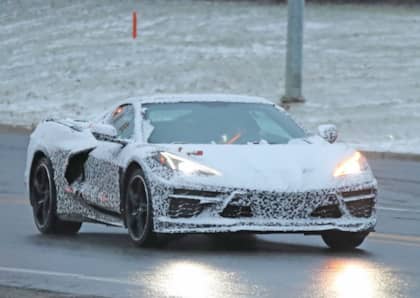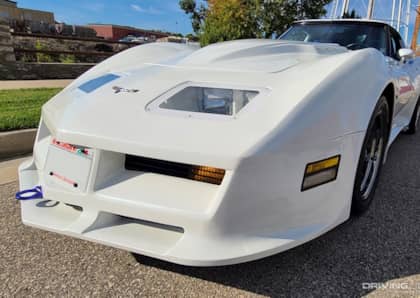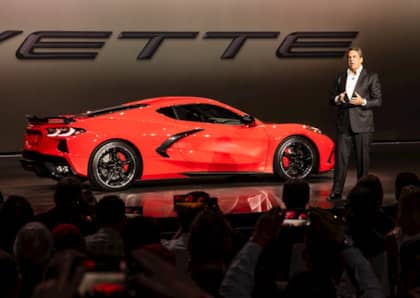Callaway Corvettes Were The First Modern American Supercars
Despite having built a reputation on the back of muscle car performance, Detroit was late to the supercar game. While Europe was busy turning out exotics like the Lamborghini Countach, the Ferrari 308, and the Porsche 930 Turbo, American automakers were stuck dealing with the deleterious effects of EPA regulations that had wrung every last bit of performance out of their former big block glory.

By the end of the 1980s the U.S. was beginning to enjoy a resurgence in fast, home-grown sports cars. The supercar universe was still well out of reach, however, as the stock Chevrolet Corvette—the closest thing to pasta rockets and autobahn menaces available—wasn't quite living up to its full potential.

It would, in fact, take a third-party tuner to unlock the high-end horsepower and titillating top speed available in the Corvette platform and finally introduce Americans to a supercar they could be proud of. The name on that badge? Callaway.
A Long Journey To The Top
Callaway Cars had actually been around since 1977 and was named after its founder, Reeves Callaway, who had been a driving instructor at the famed Bob Bondurant racing academy. In addition to producing race engines, his early interest in tuning factory cars for greater performance mostly focused on imports, including BMW, Porsche, and Mercedes-Benz. It wasn't until he turned his attention to the Corvette in 1986 that his company truly hit the next level.

There were two keys to the Callaway success story. The first was developing a reliable twin-turbo kit that could be installed on a factory Corvette, cranking horsepower from a meager 240 to a whopping 345. Torque was also up, touching the 465 lb-ft mark, which made the Corvette incredibly quick and finally brought it into the conversation alongside world-class performance stalwarts of the day.

The second crucial aspect of the Callaway strategy was partnering with General Motors to make its twin-turbo package available to Chevrolet customers ordering a Corvette through any dealership. Specifying the RPO code B2K would not only install the upgrade but it would ensure full warranty protection from GM itself, which was not something any other tuner on the market was able to offer.
Taking On All Comers
It was the start of a golden age not just for Callaway Cars, but for Corvette performance. Not content to rest on its laurels, by 1988 Callaway's twin-turbo setup would be further developed to produce 347 horses and an astonishing 100 extra lb-ft over the original specifications.

The formula for making Corvettes top 170 miles per hour was intensive, and fitting the cost of nearly $60k (including the purchase price of Chevy's coupe). A forged crank was installed inside a lower-compression version of the 5.7L V8, with T04 turbochargers, a pair of intercoolers, and a beefed-up fuel injection system also included. Callaway provided a bespoke exhaust system (one that was 49-state legal thanks to its EPA-certified catalytic converters), and buyers could also specify an 'Aerobody' package that would transform the look of the 'Vette by giving it a knife-like edge with which to slice through the atmosphere.

By 1991, Callaway Cars would boost output on its twin-turbo offering to a hefty 403 horsepower and 575 lb-ft of torque. This was the final year of the B2K option, as General Motors had created its own ZR-1 Corvette by tagging in corporate partner Lotus Engineering to create a 375hp, 32-valve dual-overhead camshaft version of its V8 engine dubbed the 'LT5.'
Everything Looks Like A Nail
There's no doubt that the B2K Callaway Corvette was a true supercar, but the company wanted to cement its status in the annals of history by building something even more over-the-top on the sport car's platform.
In 1988, eager to make a bigger name for itself and sensing that Car & Driver magazine's upcoming 'Gathering of Eagles' test would provide it with a global forum, Callaway would bring two unique B2K Corvettes and run them alongside the other contenders for the fastest street car in America. Of the pair, the 'Top Gun' experimental model would lead the entire pack with a 222.4 mph performance.

Not content, Reeves began to plan out the car's successor. In addition to seeking a higher top speed Callaway was also concerned with making the car easier to drive, in effect mimicking the daily experience of a standard Corvette while delivering insane amounts of power and quickness.

Thus was born the Sledgehammer, a car that would boast 898hp, feature its own unique aero kit, and feature a new set of suspension upgrades to go with its ferocious drivetrain. Callaway threw the aftermarket book at the Corvette's 350 cubic inch engine, including a Cosworth crankshaft and a fully outsourced rotating assembly and valvetrain. The pair of T04B turbos spun out 22 psi, and compression for the motor was a low 7.5:1.

The effort was more than worthwhile. The Sledgehammer was driven out to Ohio from the shop in Old Lyme, Connecticut, where a run a the Transportation Research Center would produce a record of 254.76 mph before the car turned around and cruised back home under its own power. To this day, the Sledgehammer remains the fastest Corvette ever built.
The First American Supercar
Although the Sledgehammer would remain a one-of-one—Callaway couldn't scare up any buyers interested in footing the vehicle's $400k price tag—the company would continue modifying Corvettes and other SUVs and sports cars, as well as constructing race cars for a wide range of different series. Callaway also continues to provide technical support and maintenance for the original B2K vehicles, which is somewhat unusual in the world of third-party tuners.

It's reasonable to posit that Callaway's immense success with the C4 Corvette was the kick in the pants GM needed to create its own super-Vettes, starting with the original ZR-1 and continuing through the Z06 (and later ZR-1 generations). Fans of American performance owe a deep debt to Reeves Callaway, whose vision of an ultra-muscled land speed record future pre-dated the Viper and shamed the Ferrari F40 and Lamborghini Diablo on its way to giving the home team something to cheer about.
More From Driving Line
- Curious about a Callaway version of the Corvette's little brother, the Camaro? Check out the coolest special edition Chevrolet Camaros you might not have heard of.











